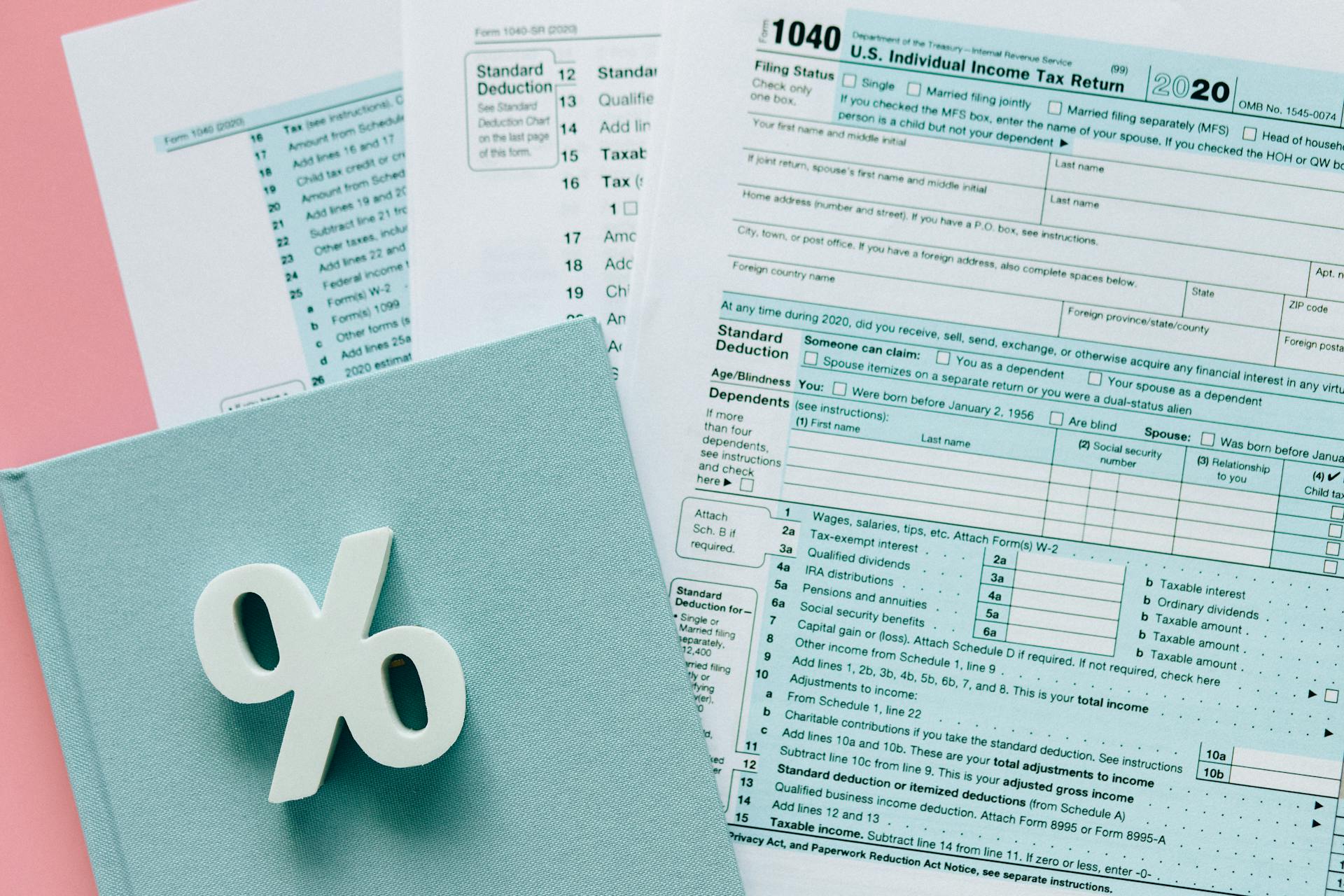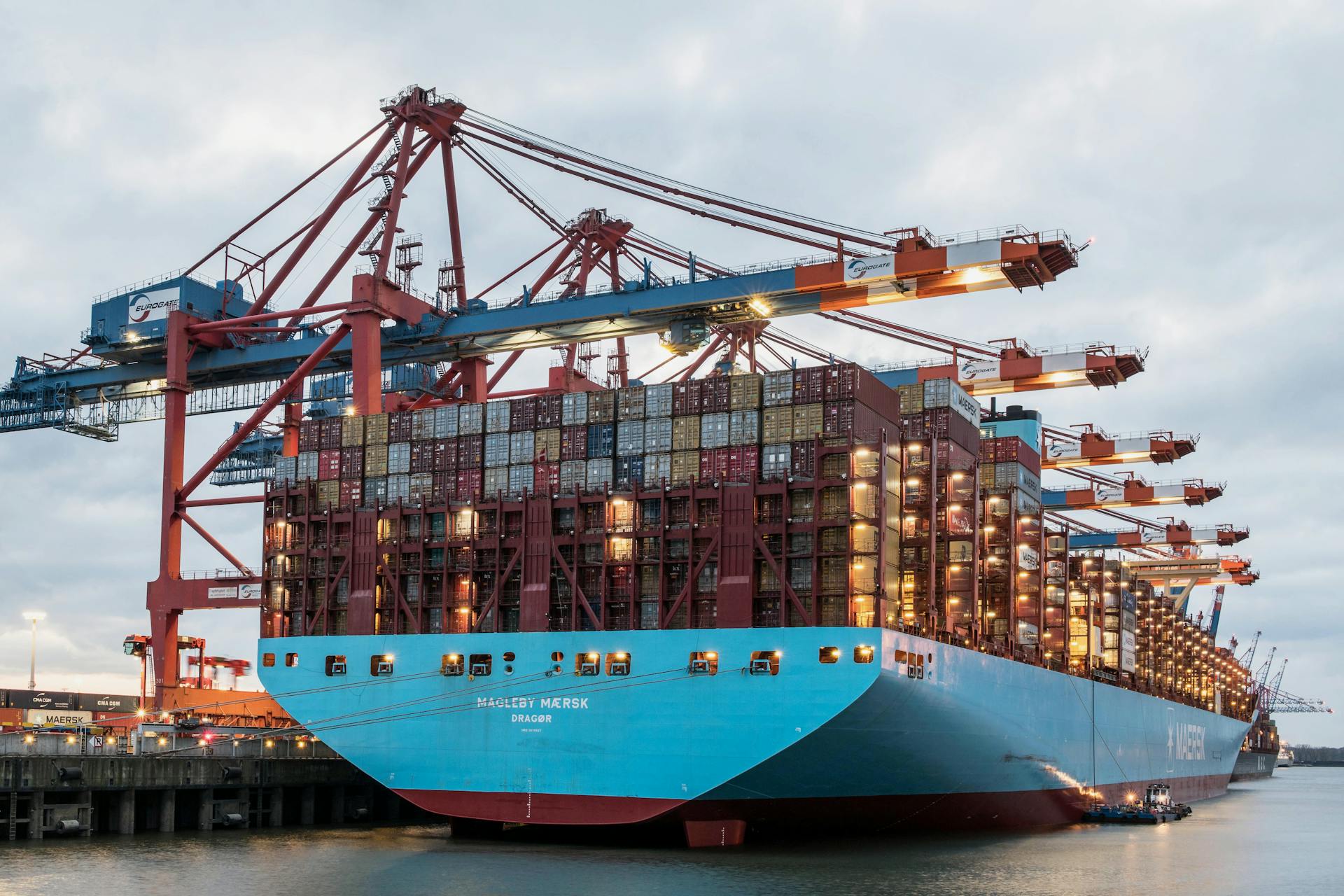
Importing goods from Canada to the US can be a complex process, but understanding the basics can make a big difference. The US Customs and Border Protection (CBP) agency is responsible for collecting import taxes on goods entering the country.
The Harmonized System (HS) code is a crucial part of the import process, as it determines the type of goods being imported and the applicable tariffs. The CBP uses these codes to classify goods and calculate the correct duties and taxes.
Goods valued at $800 or less are eligible for duty-free treatment, but this exemption only applies to certain types of goods.
Importing from Canada
Importing from Canada requires some planning and paperwork. You'll need to determine if your shipment qualifies for a Section 321 entry, which allows items valued at $800 or less to be duty-free. If your shipment exceeds this value, you'll need to make a commercial or formal entry.
To make a commercial entry, you'll need to provide a Commercial Invoice, which outlines the description and estimated value of the shipped items. You'll also need an Importer ID Number, which is either your social security number or IRS business registration number. Special import or export licenses may be required for regulated items.
The USMCA Certificate of Origin is also important, as it certifies that a shipment is eligible for preferential tariff treatment. Informal entries usually require only a commercial invoice, but a USMCA Certificate of Origin can make the shipment seamless.
Some government agencies, such as the Food and Drug Administration (FDA), may require approval for certain shipments, like food products. You'll need to register with the FDA and obtain a "Prior Notice" authorization number or PN number.
Here's a breakdown of the different types of entries:
- Section 321: Items valued at $800 or less
- Commercial or Formal Entry: Items valued over $2,500
- Informal Entry: Items valued between $800 and $2,500
You can use the Harmonized Tariff System (HTS) to calculate your import duty, which is a customs duty rate system that applies to all items. Some products, however, are exempt from these fees.
To ship goods from Canada to the US, you'll need to consider the "free on board" method used in Canada, where you're only responsible for taking the products to the nearest point of entry. The US, on the other hand, uses a "cost plus" method, where you're responsible for all costs until the product reaches the buyer.
As an importer, you'll need to determine if your goods are subject to GST/HST, which is a 5% value-added tax levied by the federal government. You'll also need to consider Provincial Sales Tax (PST), which varies from province to province.
To import goods from Canada to the US, you'll need an Importer Number, also known as a Business Tax Number or Customs-Assigned Number, which you can get through the Internal Revenue Service (IRS) if your imported goods are valued at USD 2,500 or more.
Here's a summary of the necessary documents for importing from Canada:
- Commercial Invoice
- Importer ID Number
- USMCA Certificate of Origin
- Prior Notice authorization number (for food products)
- Importer Number (for goods valued at USD 2,500 or more)
Calculating and Paying Duties
You'll need to calculate the customs duty on your goods when shipping from Canada to the US. Customs duties vary by country of origin and type of product.
The Harmonized Tariff Schedule (HTS) is used to calculate the exact rate due. You'll need to know the HTS code for your product to calculate the duty.
The minimum threshold for import tax is $800, and goods valued below that are not subject to duty.
To find out how much you'll need to pay, you'll need to check the commodity code for your product and apply the import duty rate.
For example, if you're shipping umbrellas from Canada to the US, the import duty rate is 6.5%. If the cost of the umbrellas is $28,000, you'll need to pay 6.5% of that amount, which is $1,820.
Here's a breakdown of the costs:
- Cost of goods: $28,000
- Import duty: 6.5% of $28,000 = $1,820
- Total cost: $28,000 + $1,820 = $29,820
You can use the HTS code to calculate the import duty for your product. The HTS code is a 10-digit code that classifies your product according to its type and origin.
It's always a good idea to consult with a customs broker or the US Customs and Border Protection (CBP) website to ensure you're meeting all the requirements for importing goods from Canada to the US.
Shipping and Trade Considerations

Shipping from Canada to the US requires careful planning to ensure a smooth and hassle-free process. Both Canada and the US have their own set of regulations and requirements that need to be met.
You'll need to obtain the necessary documentation, including a Bill of Lading, Commercial Invoice, and Import/Export Licenses. A Commercial Invoice must list the date of the shipment, name, address, and telephone number of both the shipper and the consignee, a detailed description of the shipped item(s), and the total estimated value of the shipment.
To become a Non-Resident Importer (NRI), a US-based company can file the necessary paperwork and application. This will make the exporting process from Canada easier, as the NRI can assume responsibility for all duties, taxes, and fees payable to the US.
Here are the different types of customs entries:
- Section 321: Items with a valuation of $800 or less are generally duty-free and fall under the Section 321 entry.
- Commercial or Formal Entry: Commercial or formal entries are shipments with a valuation of more than $2,500.
- Informal Entry: Generally, informal entries have valuations of more than $800 but less than $2,500.
Canada-US Trade and Shipping Considerations
Canada-US trade and shipping can be complex, but understanding the key considerations can make a big difference. Canada is the second-largest trading partner of the US, but the vast size of both countries and required compliance with shipping regulations can make shipping challenging.

To ensure a smooth shipping process, it's essential to collaborate with a carrier experienced in shipping items from Canada to the US. This will help you navigate customs duties and taxes, which can be costly due to the huge distance between the two countries.
In today's competitive eCommerce marketplace, customer expectations for fast and free shipping have increased. To meet these expectations, you should consider becoming a Non-Resident Importer (NRI) to assume responsibility for all duties, taxes, and fees payable to the US.
A Bill of Lading, Commercial Invoice, and Import/Export License are required for shipping from Canada to the US. The Commercial Invoice must list the date of the shipment, name, address, and telephone number of both the shipper and the consignee, a detailed description of the shipped items, and the total estimated value of the shipment.
To avoid clearance delays at the border, it's crucial to keep the paperwork up-to-date, including all necessary documentation and consulting a broker if required. You should also maintain records of your exports for a minimum of six years following the export date.
Here's a breakdown of the different types of customs entries:
For formal shipments, you'll need to provide an Importer ID Number, Commercial Invoice, Import/Export License, and USMCA Certificate of Origin. Informal entries usually require only a commercial invoice, but a USMCA Certificate of Origin can make the shipment seamless.
Difference Between Canadian and U.S. Shipping

Shipping between Canada and the U.S. has its own set of rules. Canada uses a "free on board" method for shipments coming from the U.S., where you're only responsible for taking the products to the nearest point of entry.
In contrast, the U.S. uses a "cost plus" method, which means you're responsible for all costs until the product reaches the buyer, including transportation, freight, and insurance costs. This can be a significant burden for small businesses.
Shipping costs can eat into your bottom line, especially when shipping in small quantities. It's essential to work with established couriers to reduce overheads and keep your business running smoothly.
Prohibited and Restricted Goods
If you're planning to import goods, it's essential to know what's prohibited or restricted by U.S. Customs and Border Protection (CBP).
The CBP prohibits importing goods that would injure community health. This includes items that could cause harm to individuals or the environment.
Certain goods are restricted, not entirely prohibited, but still subject to regulations. For example, importing goods that would defeat American national interests is not allowed.
These restricted goods are listed on the CBP's website, so be sure to check it out before making any import decisions.
CBP Role
The CBP, or Customs and Border Protection, is the governmental agency you'll need to deal with when importing goods into the United States. They require importers to maintain knowledge of all relevant laws, regulations, and procedures relating to importing goods into the US.
CBP is responsible for enforcing and ensuring all shipments adhere to the set rules and regulations. They have developed the Harmonized Tariff Schedule of the United States (HTSUS), a comprehensive reference manual that details the statistical categories and tariff rates of all products crossing into the US.
Importers must file the necessary paperwork and application to become a Non-Resident Importer (NRI) if they want to assume the responsibility for all duties, taxes, and fees payable to the US. This can make the exporting process from Canada easier.
CBP requires importers to maintain knowledge of all relevant laws, regulations, and procedures relating to importing goods into the United States. This includes treaties and agreements with other countries, U.S. statutes, executive orders, administrative rulings, and court decisions.
Personal vs Commercial Imports
When importing goods into Canada, it's essential to understand the difference between personal and commercial shipments. Personal Shipments attract a higher tax rate, which includes a 5% Government Sales Tax (GST) plus Provincial Sales Tax (PST), ranging from 5 to 13%, depending on your location.
If you're planning a personal shipment, be aware that you'll need to pay these additional taxes. I've seen friends who didn't factor this in end up with a bigger bill than expected.
Commercial Shipments, on the other hand, are taxed at a lower rate of 5% GST, with some exceptions. To qualify for this lower rate, you'll need to obtain an importer activation number from Canada Customs and the Canada Revenue Agency (CRA).
Here's a quick summary of the key differences:
- Personal Shipments: 5% GST + PST (5-13%)
- Commercial Shipments: 5% GST (with exceptions)
Make sure to research the specific tax rates in your province to avoid any surprises.
Canadian Goods Exemptions and Duty Relief
Canadian goods can enjoy duty relief when exported to the U.S. due to trade agreements like the North American Free Trade Agreement (NAFTA) and the USMCA.
The USMCA, an extension of NAFTA, became operational on July 1, 2020, and most Canadian agricultural products now enjoy duty relief when crossing into the U.S.
Exporting Canadian agricultural goods to the U.S. is much more affordable compared to bringing in goods from other countries not included in the NAFTA program.
You'll need a Certificate of Origin to enjoy discounted rates or exemption for your goods.
Registering with the PGA or obtaining a specific license is required for shipping certain items.
The PGA has prominent offices, but you'll need to check their website for more information on duty relief programs for exporters.
Customs duties for Canadian goods vary by product and country of origin, and you'll need to know the Harmonised Tariff Schedule (HTS) code to calculate the exact rate due.
Regulations and Compliance
To navigate the regulations and compliance for importing goods from Canada to the US, you'll need to consider customs duty and tax. The minimum threshold for import tax is $800, and goods valued below that are not subject to duty.

The US Customs and Border Protection (CBP) enforces customs rules, and you'll need to know the Harmonised Tariff Schedule or HTS code to calculate the exact rate due. You can use a Duty and Tax Calculator to determine how much you'll be expected to pay at customs.
To clear customs, you'll need to provide the required documents, including a Commercial Invoice, a USMCA Certificate of Origin, and an Importer ID Number. Informal entries usually require a commercial invoice only, but a USMCA Certificate of Origin can make the shipment seamless.
Here's a breakdown of the different types of entries:
- Section 321: Items with a valuation of $800 or less are generally duty-free and fall under the Section 321 entry.
- Commercial or Formal Entry: Commercial or formal entries are shipments with a valuation of more than $2,500.
- Informal Entry: Generally, informal entries have valuations of more than $800 but less than $2,500.
Additionally, you may need to obtain approval from government agencies, such as the Food and Drug Administration (FDA), if you're shipping food products to the US.
Canadian Customs Entry
Canadian Customs Entry is a crucial step in importing goods into Canada. You'll need to submit a Customs Entry B3 Form for every import, which includes the importer and exporter identification, duty and taxes, and a detailed description of the imported goods.
To determine whether your shipment will be immediately released or inspected, the Canada Border Services Agency (CBSA) will review your goods once they arrive at the Canadian border. You'll be required to submit all import documents at this stage and pay any tax or duty on your imported goods.
Here's a list of the required documents for a Canadian Customs Entry:
- Commercial Invoice: A Commercial Invoice outlines a description of the shipped item(s), including their estimated value.
- USMCA Certificate of Origin: This certificate certifies that a shipment is eligible for the preferential tariff treatment agreed between the USMCA.
- Importer ID Number: This is either your social security number or IRS business registration number.
Note that the required documents may vary depending on the type of shipment and the goods being imported. Be sure to check the specific requirements for your situation.
NAFTA Certificates
NAFTA Certificates are required for shipping into the U.S. to verify the country of manufacture. This is necessary to determine if the shipments qualify for preferential tariff treatment under the NAFTA treaty.
To qualify for preferential tariff treatment, shipments must meet safety and regulatory standards. If they do, you can ship these products freely across Canadian and U.S. borders.
You'll need to preserve the original or a copy of the NAFTA certificate for at least six years in Canada. This is a requirement to ensure compliance with NAFTA regulations.
NAFTA Certificates can help reduce or eliminate duty on eligible shipments. This can save you money on customs duties and make your shipping process more efficient.
Tips and Precautions

Do in-depth research on border clearance requirements for a hassle-free shipping process.
Take a few days as a buffer for transit time, especially during the freezing winter season, anticipating delays due to harsh weather conditions.
Incomplete or missing documentation is one of the common causes of clearance delays at the border, so keep the paperwork up-to-date.
Buy insurance for high-value or fragile items to cover the item cost in case of damage or loss during shipping.
Maintain records of your exports for a minimum of six years following the export date, as required by customs regulations.
State the product's HTS code on the commercial invoice to help the CBP accurately determine the duty to charge on the product.
Always provide the correct information on the commercial invoice to avoid penalties and fines.
Find a competent and reliable customs broker to help determine which bond best suits your product line and business goals.
Maximize preferential trade tariffs by obtaining a Certificate of Origin to enjoy duty exemptions and special rates.
Consider using couriers like USPS and Canada Post, which offer special rates for businesses that regularly use their cross-border shipping services.
Frequently Asked Questions
How much tax do I pay to import goods to USA?
Import duties in the USA range from 0 to 37.5%, with an average rate of 5.63%, depending on the type of goods and country of origin
How much is import duty into the USA?
Import duty into the USA typically ranges from 0 to 37.5%, with an average rate of 5.63%, but some goods are exempt or subject to reduced rates. Check the specific duty rates for your goods and explore free trade agreements to minimize costs.
Sources
- https://wise.com/us/import-duty/from-canada
- https://shippingchimp.com/blog/shipping-from-canada-to-the-us-customs-duty-taxes-and-exemptions/
- https://impack.co/blogs/news/taxes-to-pay-when-shipping-from-canada-to-the-u-s
- https://www.ghy.com/trade-talk/canada-vs-us-import-laws/
- https://clearit.ca/online-customs-broker-tools/canada-customs-duty-tax-calculator
Featured Images: pexels.com


